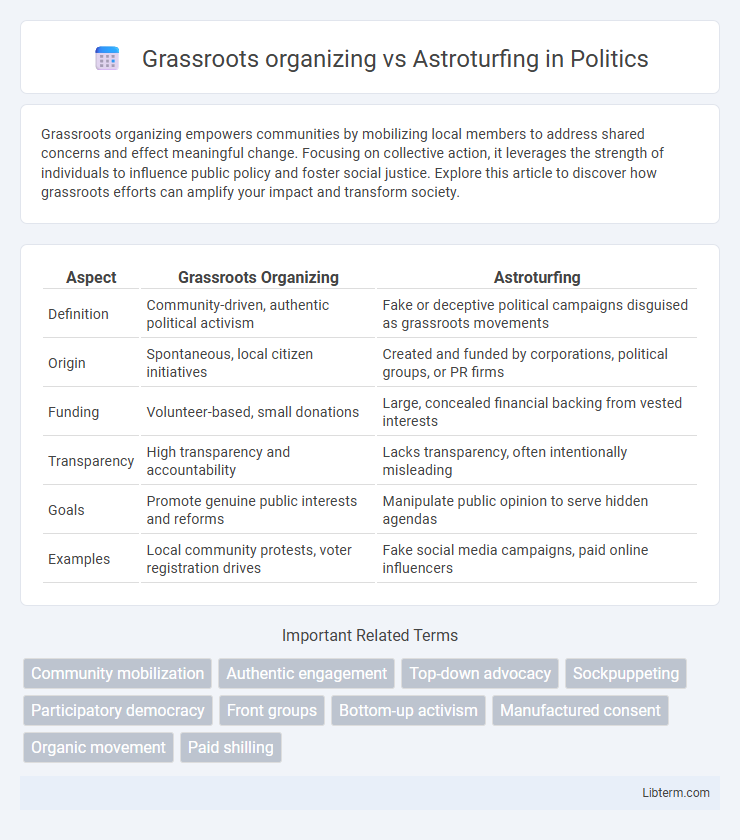Grassroots organizing empowers communities by mobilizing local members to address shared concerns and effect meaningful change. Focusing on collective action, it leverages the strength of individuals to influence public policy and foster social justice. Explore this article to discover how grassroots efforts can amplify your impact and transform society.
Table of Comparison
| Aspect | Grassroots Organizing | Astroturfing |
|---|---|---|
| Definition | Community-driven, authentic political activism | Fake or deceptive political campaigns disguised as grassroots movements |
| Origin | Spontaneous, local citizen initiatives | Created and funded by corporations, political groups, or PR firms |
| Funding | Volunteer-based, small donations | Large, concealed financial backing from vested interests |
| Transparency | High transparency and accountability | Lacks transparency, often intentionally misleading |
| Goals | Promote genuine public interests and reforms | Manipulate public opinion to serve hidden agendas |
| Examples | Local community protests, voter registration drives | Fake social media campaigns, paid online influencers |
Introduction to Grassroots Organizing and Astroturfing
Grassroots organizing involves genuine community-driven efforts where local individuals mobilize around shared concerns to influence social or political change. Astroturfing, in contrast, mimics grassroots movements but is orchestrated by organizations or entities to create a deceptive appearance of widespread support. Understanding the distinction between authentic grassroots activism and manufactured astroturf campaigns is crucial for evaluating the legitimacy of public advocacy.
Defining Grassroots Movements
Grassroots movements are community-driven efforts that mobilize local individuals to advocate for social or political change, emphasizing genuine participation and collective action from the ground up. These movements are characterized by their organic development, transparent leadership, and authentic representation of the community's interests. Unlike astroturfing, grassroots organizing builds credibility through widespread local engagement rather than orchestrated campaigns funded by external entities.
What is Astroturfing?
Astroturfing is a deceptive practice where fake grassroots movements are created to simulate genuine public support for a cause, policy, or organization. It often involves orchestrated campaigns funded by corporations, political groups, or special interests aiming to manipulate public opinion and influence decision-makers. Unlike authentic grassroots organizing, astroturfing masks its origins and presents itself as spontaneous citizen activism.
Key Differences Between Grassroots and Astroturfing
Grassroots organizing involves genuine community-driven efforts where local participants actively advocate for social or political change, emphasizing authentic public engagement and organic support. Astroturfing, by contrast, is a deceptive practice where orchestrated campaigns mimic grassroots movements using fake participants or paid individuals to create an illusion of widespread consensus. Key differences include the source of support--authentic versus fabricated--and transparency, with grassroots movements being open and inclusive, while astroturfing relies on hidden agendas and manipulation.
Tactics Used in Grassroots Organizing
Grassroots organizing employs tactics such as door-to-door canvassing, community meetings, and mobilizing local volunteers to build authentic support and foster genuine community engagement. These efforts emphasize direct communication and relationship-building to influence public opinion and policy from the ground up. In contrast, astroturfing relies on fabricated or scripted campaigns often orchestrated by organizations to create a false impression of widespread grassroots support.
Common Strategies in Astroturf Campaigns
Astroturf campaigns often employ tactics such as fake grassroots rallies, orchestrated social media blitzes, and paid spokesperson endorsements to simulate genuine public support. These strategies manipulate public opinion by creating the illusion of widespread consensus, using bots, shell organizations, and misleading messaging to amplify influence. The contrast with authentic grassroots organizing lies in astroturfing's reliance on artificial, top-down orchestration rather than organic, bottom-up mobilization.
Real-World Examples of Grassroots Success
Grassroots organizing achieved significant success in the Civil Rights Movement of the 1960s, where local activists mobilized communities to challenge segregation and fight for voting rights, leading to landmark legislation such as the Voting Rights Act of 1965. In contrast to Astroturfing's artificial campaigns, the 2011 Arab Spring demonstrated grassroots power as citizens organically used social media to coordinate protests and demand political change across multiple countries. These real-world examples highlight how authentic community-driven efforts can create lasting social and political impact.
Notable Cases of Astroturfing Exposure
Notable cases of astroturfing exposure include the 2009 debate on climate change where organizations like ExxonMobil funded fake grassroots campaigns to sway public opinion. The anti-net neutrality campaign in 2017 saw widespread use of automated fake comments and astroturf tactics to create the illusion of public opposition. These instances highlight the manipulation of public discourse by masking corporate and political agendas as authentic community movements.
Impact on Public Opinion and Policy
Grassroots organizing authentically mobilizes community members, generating genuine public support that pressures policymakers to enact responsive and inclusive legislation. In contrast, astroturfing creates a misleading appearance of widespread consensus through orchestrated campaigns, often distorting public opinion and weakening democratic decision-making. The authentic engagement of grassroots efforts typically results in more sustainable and impactful policy changes compared to the transient influence of astroturf initiatives.
Identifying Authentic vs. Manufactured Movements
Grassroots organizing is characterized by genuine community-driven efforts where local participants initiate and sustain campaigns, reflecting authentic concerns and organic support. Astroturfing involves orchestrated campaigns funded and managed by organizations, designed to simulate grassroots movements but lacking real, widespread public involvement. Identifying authentic movements requires examining the source of funding, participant engagement levels, and transparency of motives, distinguishing true grassroots from manufactured Astroturf efforts.
Grassroots organizing Infographic

 libterm.com
libterm.com